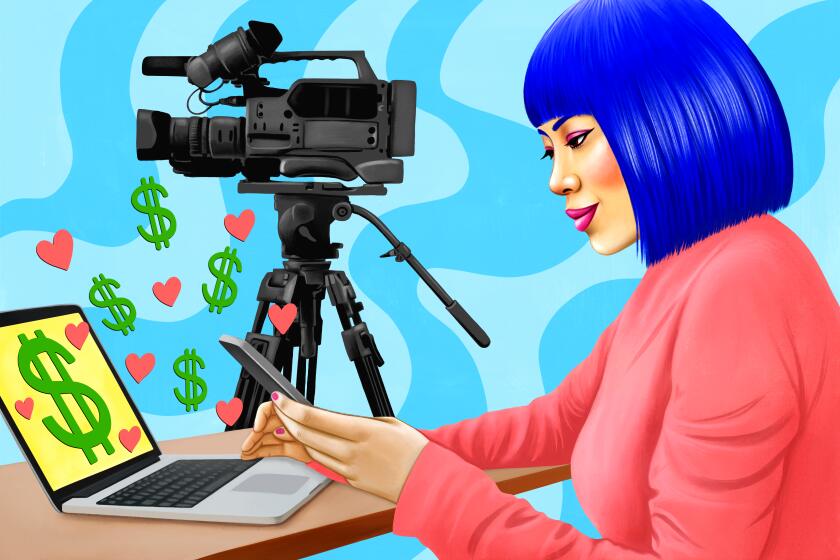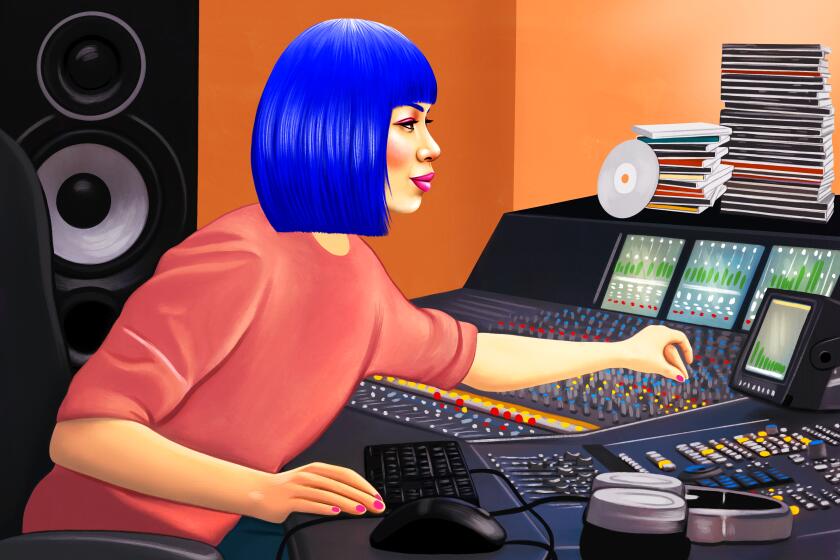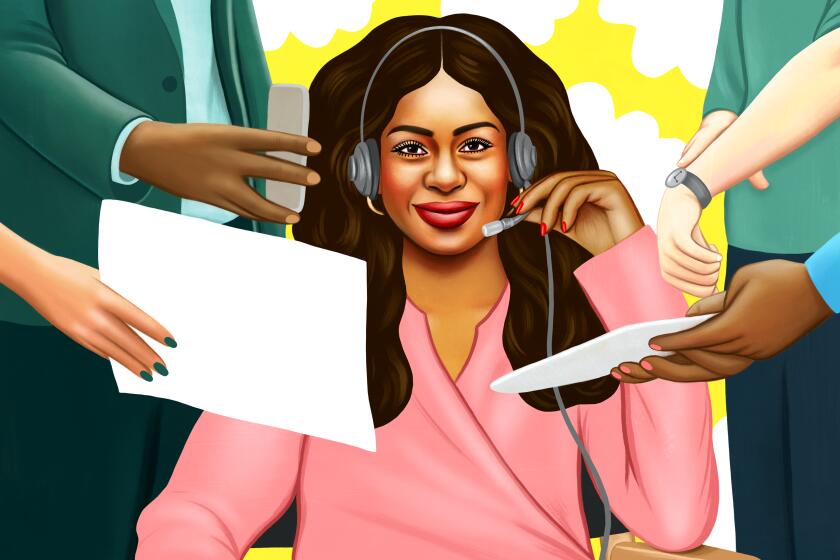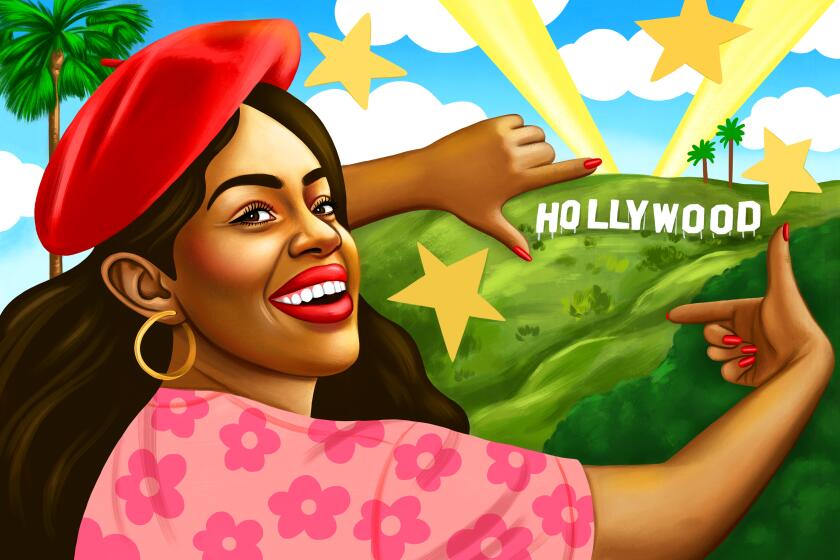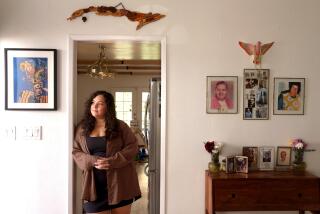Explaining Hollywood: How to get a job as a production designer
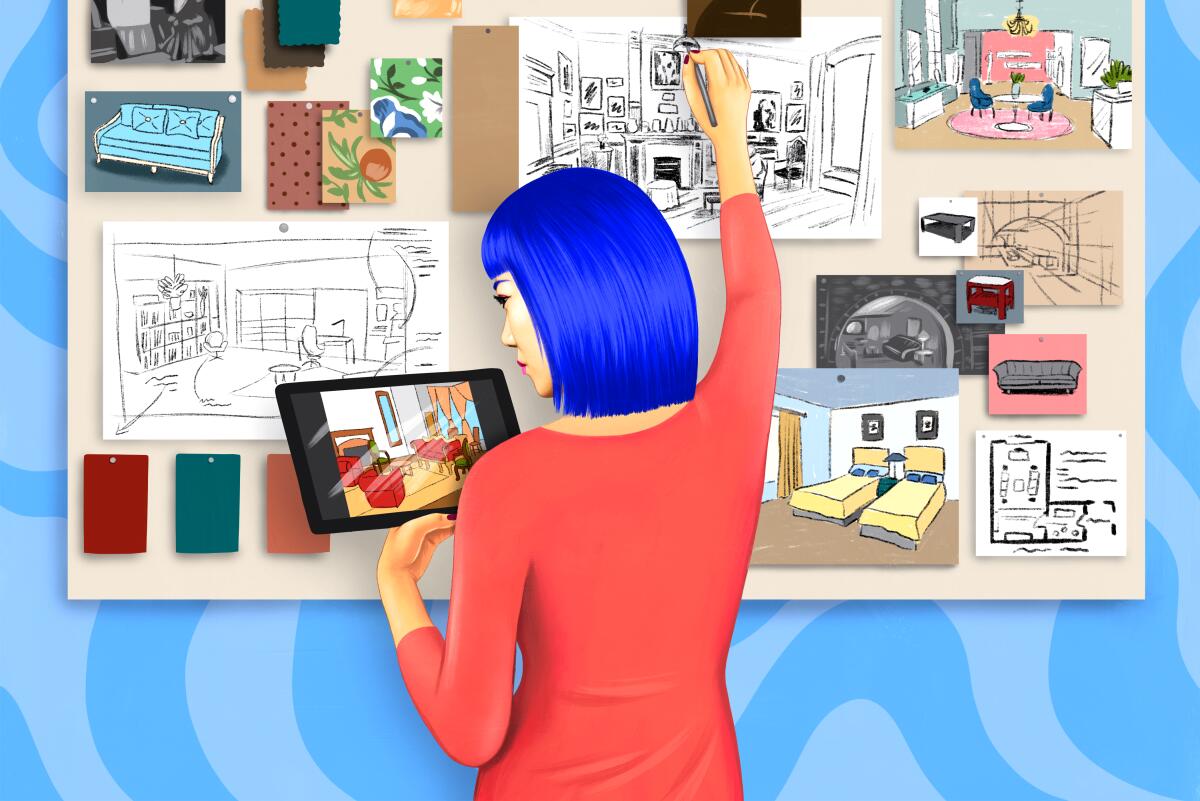
In the film “Everything Everywhere All at Once,” the character Evelyn Wang (played by Michelle Yeoh) is struggling to make a living as owner and operator of a laundromat before she harnesses her powers from alternate universes to save her world and beyond.
In the opening scene of the critically acclaimed film, Wang sits in her apartment’s dining room, organizing receipts for taxes and preparing food for her father.
Her environment illustrates her state of mind. On the wall behind her is a shelf cluttered with knickknacks and laundry bags. The table in front of her is filled with endless piles of paper.
Jason Kisvarday, the film’s production designer, worked with his team to bring the Wang apartment to life. Inspired by memories of his friends’ former homes, he imagined a Los Angeles dingbat apartment and a boxy room with aluminum-framed windows — an “incredibly non-special” space.
He gave his set decorator, Kelsi Ephraim, 50 reference photos of messy apartments and told her to use them as inspiration, “but [to] own it and have fun.” The project’s art director, Amelia Brooke, chose the paint colors of the apartment and worked with the carpenters to build it.
These details are Kisvarday’s favorite part of being a production designer, but it’s just one task in his job description. A production designer works with the director and the producer (or showrunner) to build a story’s world. The person hires the staff for the art department and keeps tabs on the budget and schedule.
To find out what it takes to become a production designer and how to land the job, The Times spoke with Kisvarday and five of his fellow professionals — Toni Barton (“Archive 81” and “Jessica Jones”), James Connelly (“The Kelly Clarkson Show” and “The Voice”), Bill Groom (“The Marvelous Mrs. Maisel” and “Eat Pray Love”), Judy Rhee (“Better Call Saul” and “El Camino: A Breaking Bad Movie”) and Desma Murphy (“Cheaper by the Dozen” and “Malignant”). Here’s what they had to say.
Who becomes a production designer?
Many of the pros The Times spoke to have a background in architecture. And all of them said that a huge draw of being a production designer is the influence they have to visually guide a story.
Kisvarday loves old and clunky cars. The louder and weirder, the better, he said. As Kisvarday worked with “Everything Everywhere” directors Daniel Kwan and Daniel Scheinert, he thought it would be funny if the Wang family had a motor home to make clean-laundry deliveries. The motor home idea was written into the later versions of the script.
“I cleared my plate and said, ‘I’m going to look through Craigslist and Facebook Marketplace at 1,000 motor homes until we find the right one,’” he said.
But it’s always a collaborative effort. Barton said you have to be a listener, taking in the notes and comments of the director, showrunner or producer.
You’ll be given direction, but you should share your own ideas as well, she said. She recommends immersing yourself in architecture, fashion, history and sociology to be able to use those references in the world that you’re building.
Groom said you have to be able to juggle multiple duties and stay organized, because it’s a lot of responsibility. He remembers getting to “The Marvelous Mrs. Maisel” set for a day of shooting.
“I looked up and there were just about 100 people walking towards stage to go in and start working, and it had never occurred to me just how much trust was given to me to have something ready for 100 people to show up,” he said.
You also need to have patience, said Rhee. You’ll be working with a lot of different personalities, and sometimes you’ll have to negotiate ideas or budget needs.
You have to be a problem solver, figuring out “how to get the best out of people from your team,” she said. You can’t do everything, so you’ll need to rely on the team that you’ve assembled.
Also, Rhee said it’s important to have endurance because the schedule on a production can be challenging. A television series can be even more demanding than feature films: You’re creating something new every 10 days, she said. You’ll have to manage your preparation time and think about how many hours you’ll need to creatively think things through.
So you want to direct, but you don’t have a wealthy benefactor or thousands of dollars to spare? It might be time to think about raising money from the throngs of movie lovers.
How do you get started?
Most of the designers The Times interviewed started as production assistants and made their way into the art department on set. Others had internships or assisted on Broadway sets. But all agreed that while you’re starting out, any time you can design an environment for a low-budget film, a student film or other project, do it.
Connelly grew up around blueprints. His father was an architect, and his mother was an art teacher. He found his passion being part of the backstage production crew of his high school drama club.
“I felt it was really empowering to wear a headset and call cues during a stage performance,” he said.
He attended Rutgers University and earned a bachelor of fine arts degree with a concentration on design because he liked designing sets.
Barton attended USC’s School of Architecture, and during that time, she regularly hung out with friends who would ask her to design sets for a show or short film they were making. She continued her education by getting a master of fine arts in art direction and scenic design at New York University. She later got hands-on experience by assisting Broadway set designers and working at a couple of set design firms.
Murphy studied fine arts and architecture but said she didn’t have any connections into the entertainment industry postgraduation. She got a helpful internship with the Television Academy but was still having trouble breaking in.
She went back to school to earn her MFA in theater and film design at NYU and got a production assistant job in Los Angeles that got her into the union.
But having a specific degree in architecture or fine arts isn’t a requirement. Kisvarday earned his bachelor’s degree in business at Loyola Marymount University. He uses those skills to manage his team, the production budget and logistics.
Everything else he learned on the job. After working behind a desk, he quit to join an effects shop called New Deal Studios in Santa Monica that specialized in miniatures. He later became a production assistant in the art department to get the on-set experience and learn about the different departments that work together to make a film.
Actors who have chosen to pursue Hollywood later in life as a second career share their experiences and advice.
What are the career paths?
The production designer leads the art department, overseeing a set designer, art director, assistant art director and other artists. All play a large role in building a story’s world, so it’s good to have experience in the art department before you have to deal with every aspect of bringing the vision to physical fruition.
Kisvarday started working with props before assisting in other parts of the art department. Murphy worked on numerous films as a supervising art director for production designer Bill Brzeski (known for designing “Aquaman,” “The Hangover” and “Matilda”) before becoming a production designer. Her job was to hire the art department, ensure the department’s budget was on track and share information with all the other departments.
Pros can move fluidly from one job within the department to another. For instance, Murphy still goes back and forth between stints as production designer and art director.
A music supervisor combines the skills of a disc jockey and a negotiator to help pull together the soundtrack of a film or TV show.
How do you make money?
Reflecting on the beginnings of their careers, most of the professionals talked about having side gigs, renting apartments with roommates and never turning down an opportunity.
“I think the hardest thing for most people getting started is ... getting enough freelance work to make ends meet,” Kisvarday said.
Kisvarday didn’t spend too much time thinking about how much money he made on a project when he was starting out. But after gaining experience, he created a minimum rate of $500 for about two weeks of work.
Once he was able to join the Art Directors Guild, represented by IATSE Local 800, he moved to the union’s pay scale. The local has contracts with studios and production houses that set minimum rates for its members’ services on film and TV projects.
“So pre-union, the money was terrible, and I was able to make it work by working nonstop, just overlapping job to job for a bunch of years,” Kisvarday said.
Once he joined the union, he said he was able to have health insurance, a livable wage and better working conditions.
Connelly has worked on productions through the union, but he’s also paved his own way through his production design company, J.P.Connelly. He said that ultimately, the minimums provide a benchmark for your market value, but it’s possible to negotiate for at least as much or more outside of the union as well.
Every year, thousands of kids decide they want to try to land jobs as professional actors. The learning curve for parents is steep, and the path can be costly.
How is this career different compared to 10 or 25 years ago?
Groom said designers used to physically build out entire sets. For example, you would build a wall that was about 20 to 30 feet high. Now, he said, the wall needs to be only about 12 feet high so it covers the background behind the actors — and then the visual effects team will create the rest of the wall digitally.
There are still hand-drawn sketches of a production designer’s vision, but many now use a computer or another device. Groom said this has been beneficial, especially since COVID-19 has made remote work a new normal.
But he’ll always have a special place for hand-drawn work.
“I was taught years ago that the artist’s tool — a brush, pencil, eraser, whatever — is an extension of the artist’s hand,” Groom said.
Technology has also fueled the demand for more films and television shows, as the number of streaming services grows.
That demand means more people on sets creating more content. There’s also more work being done to diversify these sets, Barton said, as the industry is changing. Part of that change is happening through United Scenic Artists (IATSE Local 829), the union representing a broader selection of artists, designers and craftspeople. The local’s Equity Through Design Mentorship program has its members mentor college, high school and junior high school kids to educate them about opportunities in this field.
Film producers will tell you that there’s no typical day in the job -- and there’s no single path to becoming a producer. But there are traits you can develop and entertainment industry paths to follow that will set you up for a career in Hollywood.
What advice do pros always hear that is wrong?
If you’re told by someone that there’s only one way to get into this career, Barton said, that “just isn’t so.” There are many different paths.
“If there’s a roadblock, then turn around and go in the other direction,” Barton said. “Don’t let somebody else’s roadblock be your roadblock.”
What’s some good advice?
You get what you put into the job. Kisvarday said the people that he sees put the most into their work succeed quickly. “If it’s something you really want, put everything into it because it will pay off.”
Take projects that challenge you. Connelly said take on projects that make you leave your daily existence and submerse yourself in them.
Draw every day. “The fastest way to communicate [in this field], unless you’re a super-speed typer and Pinterest-er, is doing a doodle,” Connelly said.
Careers in the entertainment industry can be mysterious for those just starting out, and even for those working in the business. The Los Angeles Times brings you explainers and advice for starting and building your career in Hollywood.
More to Read
Inside the business of entertainment
The Wide Shot brings you news, analysis and insights on everything from streaming wars to production — and what it all means for the future.
You may occasionally receive promotional content from the Los Angeles Times.
